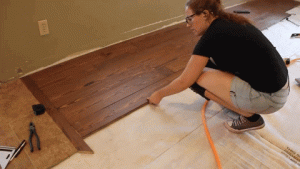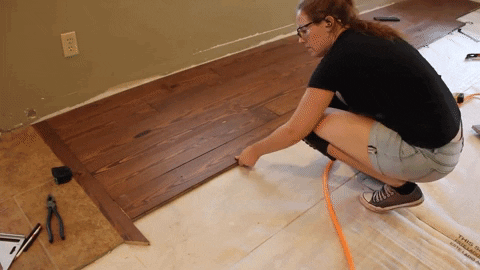
Hardwood flooring has graced homes for centuries, offering a timeless elegance and unparalleled durability that few other flooring options can match. If you’re considering a home upgrade, understanding the nuances of hardwood is crucial.
This comprehensive guide will delve into everything you need to know, from the different types and styles to installation, maintenance, and long-term care.
Why Choose Hardwood Flooring?
Before diving into the specifics, let’s explore the compelling reasons why hardwood remains a top choice for homeowners:
- Aesthetic Appeal: Hardwood floors exude warmth and natural beauty, enhancing any interior design style, from classic to contemporary.
- Durability and Longevity: With proper care, hardwood floors can last a lifetime, making them a wise long-term investment.
- Increased Home Value: Hardwood floors are a sought-after feature that can significantly boost your property’s resale value.
- Improved Indoor Air Quality: Unlike carpets, hardwood floors don’t trap allergens, dust, or pet dander, contributing to a healthier living environment.
- Versatility: Hardwood comes in a vast array of species, colors, and finishes, allowing for endless customization.
- Easy Maintenance: Regular sweeping and occasional mopping are typically all that’s required to keep hardwood floors looking their best.
Types of Hardwood Flooring:
Understanding the different types of hardwood is essential for making an informed decision.
- Solid Hardwood:
- Made from a single piece of wood.
- Offers exceptional durability and can be sanded and refinished multiple times.
- Sensitive to moisture and humidity, making it unsuitable for basements or bathrooms.
- Common species include oak, maple, cherry, and walnut.
- Engineered Hardwood:
- Consists of multiple layers of wood, with a top layer of solid hardwood veneer.
- More stable than solid hardwood and less susceptible to warping or cupping.
- Suitable for a wider range of environments, including basements and some areas with moderate humidity.
- Can be installed over concrete slabs.
- Offers similar aesthetic appeal to solid hardwood.
Hardwood Species and Their Characteristics:
The choice of wood species significantly impacts the look, feel, and performance of your floors.
- Oak:
- A classic and popular choice known for its durability and prominent grain patterns.
- Available in red oak and white oak, each with distinct color variations.
- Highly versatile and suitable for various styles.
- Maple:
- Features a smooth, fine grain and a light, creamy color.
- Known for its hardness and resistance to dents and scratches.
- Creates a clean and modern aesthetic.
- Cherry:
- Characterized by its rich, reddish-brown hue and smooth, uniform grain.
- Adds a touch of elegance and warmth to any space.
- May darken over time with exposure to sunlight.
- Walnut:
- Offers a dark, luxurious appearance with a distinctive grain pattern.
- Known for its strength and stability.
- Adds a touch of sophistication to interiors.
- Hickory:
- Very hard and durable.
- Displays a strong grain variation.
- Good for high traffic areas.
- Exotic Woods:
- Such as Brazilian cherry, bamboo, and acacia.
- Offer unique colors and grain patterns.
- Vary in hardness and durability.
Hardwood Floor Styles and Finishes:
Beyond species, the style and finish of your hardwood floors play a crucial role in creating the desired look.
- Plank Width:
- Wide planks (5 inches or more) create a grand and spacious feel.
- Narrow planks (2-3 inches) offer a more traditional and formal look.
- Grain Pattern:
- Plain sawn, quarter sawn, and rift sawn cuts create different grain patterns.
- Each pattern offers a unique aesthetic appeal.
- Finish:
- Prefinished floors are sanded, stained, and sealed at the factory, offering convenience and durability.
- Unfinished floors allow for custom staining and finishing on-site.
- Finish types include polyurethane, lacquer, oil, and wax.
- Texture:
- Handscraped, wirebrushed, and distressed finishes add character and a rustic touch.
- Smooth finishes offer a sleek and modern look.
Installation Considerations:
Proper installation is crucial for the longevity and performance of your hardwood floors.
- Subfloor Preparation:
- A level and stable subfloor is essential for a successful installation.
- Concrete, plywood, and OSB are common subfloor materials.
- Acclimation:
- Hardwood flooring needs to acclimate to the room’s temperature and humidity for several days before installation.
- This prevents warping and shrinking.
- Installation Methods:
- Nailing, stapling, gluing, and floating are common installation methods.
- The appropriate method depends on the type of hardwood and subfloor.
- Professional Installation:
- Hiring a qualified professional ensures a flawless installation and avoids costly mistakes.
Maintenance and Care:
Proper maintenance is essential for preserving the beauty and longevity of your hardwood floors.
- Regular Cleaning:
- Sweep or vacuum regularly to remove dirt and debris.
- Use a damp mop with a mild cleaner designed for hardwood floors.
- Preventing Scratches and Dents:
- Use furniture pads to protect floors from scratches.
- Trim pet nails regularly.
- Avoid wearing shoes with high heels or cleats.
- Controlling Humidity:
- Maintain a consistent humidity level to prevent warping and cupping.
- Use a humidifier or dehumidifier as needed.
- Refinishing:
- Solid hardwood floors can be sanded and refinished multiple times to restore their original beauty.
- Engineered hardwood can also be refinished, but fewer times due to the thinner top layer.
Addressing Common Hardwood Floor Problems:
- Gaps: Gaps can appear due to changes in humidity. Maintaining constant humidity will lessen this issue.
- Cupping and Warping: Caused by excessive moisture. Address moisture issues immediately.
- Scratches and Dents: Can be minimized with proper care. Deep scratches can be spot repaired, or the floors can be refinished.
- Fading: Caused by sun exposure. Use curtains or blinds to protect floors.
Conclusion:
Hardwood flooring remains a timeless and valuable investment for homeowners. By understanding the different types, species, styles, and maintenance requirements, you can make an informed decision that will enhance the beauty and value of your home for years to come.
Whether you choose solid or engineered hardwood, oak or maple, a smooth or handscraped finish, the natural elegance and durability of hardwood will undoubtedly elevate your living space.
